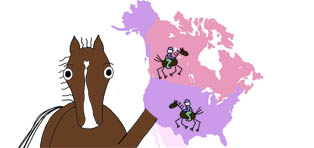Mohavedailynews.com - Full Article
By KRISTENA HANSEN/Cronkite News Service
Sunday, March 7, 2010
ST. DAVID - Arroyo may not have the size of a quarter horse, the speed of a thoroughbred or the elegance of an Arabian.
But this colonial Spanish horse can eat nearly any native grass, has hooves so firm they don't require shoes and is renowned for its stamina. In the late 1600s, its ancestors carried Father Eusebio Kino from Mexico into present-day Arizona, where he credited the breed for helping him establish missions.
As cattle ranchers sought bigger and stronger horses in the 300-plus years since, they cross-bred the colonial Spanish horse into many of today’s most popular pedigrees. It's nearly vanished in its native Spain and is a novelty breed kept alive by people such as Marjorie Dixon, Arroyo's owner.
Ten years ago, Dixon sold her quarter horses and began breeding the colonial Spanish horse at her 1,200-acre ranch set beneath the Dragoon Mountains of southeastern Arizona. Her passion inspired a suggestion from her husband, Jerry.
"My husband looked at me and said, 'Marjorie, these horses should be the Arizona state horse. You should really get on that,'" Dixon said with a laugh.
That could happen this year, as a bill inspired by Dixon and other members of Arizona's Colonial Spanish Horse Project is moving through the state Legislature. HB 2634, sponsored by Rep. Patricia V. Fleming, D-Sierra Vista, is awaiting a vote by the full House that would send it to the Senate.
If it passes, the colonial Spanish horse would join a list of state emblems that includes an official fossil (petrified wood), amphibian (tree frog) and neckwear (bola tie).
"These horses are a state treasure because of the history behind them," said Fleming, whose district includes St. David. "This is recognizing a piece of Arizona heritage."
More...

No comments:
Post a Comment